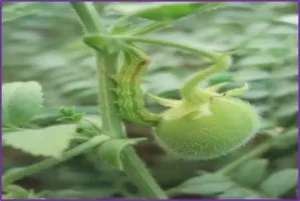Table of Contents
Chickpea :: Gram Pod Borer
Gram pod borer scientific name:- Helicoverpa armigera
Gram pod borer is the most damaging pest of chickpea ecosystem and is reported to cause severe crop loss. Helicoverpa armigera larva feeds voraciously on chickpea crop from seedling stage to crop maturity.

Full grown larvae can damages up to 7-40 pods. The population build up of this pest is slow at early vegetative growth stage and with the advent of favourable weather, it starts picking up, the crop enters into reproductive stage and by the time the seeds are formed pest population density becomes very high, thus inflicting heavy losses.
Symptoms:-
- The young larvae can be of pinkish, yellow, black orange, or grey colour. On the back of larvae, light/dark coloured strips can be seen.
- Young larvae feed on the tender portion of the leaves and shoots by making scratches. Second and subsequent grown-up larvae consume whole leaves, leaf buds, flower buds and flowers.
- The 3′ instar larvae feed on the grains after making a hole in pods and thrusting its head therein hence called as pod borer.
- After feeding on pods / these larvae enter to next phase i.e., pupae.
- Pupa survive in soil , give rise to an adult insect within days ( 8-10 ) after pupal stage.
- The life cycle (period) of the pod borer depends on the temperature, humidity and other factors.
Control of Gram Pod Borer :-
- Periodic monitoring of crop especially at the reproductive phase of the crop is essential.
- Cultivation of tolerant varieties like JG 130, JG 322, JG 11, JG 74, IPC 97-67 (SCS3), RSG 888 etc.
- Deep summer ploughing, timely sowing, early maturing varieties, intercropping with mustard, linseed or barley helps minimizing losses.
- Installation of pheromone traps 5-6 traps/ha for monitoring the population build up.
- Erecting of ‘T’ shaped wooden/stick structures in field@ 35-40/ha, provide proper place for insectivorous birds. Removal of these perches at crop maturity to avoid damage to grains.
- Apply neem based insecticide @ 5% with 1% soap solution at flowering stage when eggs and early instar of pest are observed in the fields.
Gram pod borer biological control :-
- Biological control through nuclear polyhedrosis virus (HaNPV) 250 LE/ha.
Chemical control:-
- At podding stage if the larval population crosses ETL ( 1 larva/m row length), apply profenophos 50 EC@ 1500ml/ha dissolved in 500 liters water or indoxacarb 14.5 SC 500ml/ha or spinosad 45 SC 60 ml/ha or fluebendamide 48 SC @ 50 ml/ha should be applied to reduce the larval population effectively.
- Feedback:- After Reading Post, Share Your valuable feedback for Improvement agrigyan.in For Your Better Experience. Click here
- Contact:- If You Face Any Error and What the Need To You then Contact us :- sragrigyan@gmail.com / Comment Below the Post.
What is scientific name of Gram pod Borer ?
Helicoverpa armigera



Community Discussion
Share your farming experiences and insights